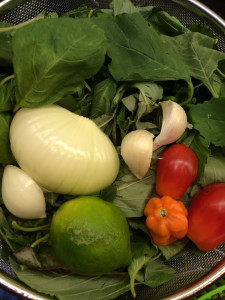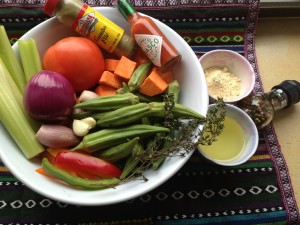 Family History Month is celebrated in October by genealogists worldwide. This is a perfect time to celebrate your food legacy. I learned so much about my Southern and Caribbean genealogy and culture through the food we ate at home.
Family History Month is celebrated in October by genealogists worldwide. This is a perfect time to celebrate your food legacy. I learned so much about my Southern and Caribbean genealogy and culture through the food we ate at home.
Here are 3 ways to honor your family’s food legacy:
- Share memories of food you ate growing up. Don’t take your culinary traditions for granted. Be proud of all the crazy things you ate at home!
- Create a family cookbook by collecting recipes. Read or write about how food intersects with culture and history.
- Travel to your ancestral homeland to taste and witness your authentic roots. The land, waterways, air, plants, animals, fish, fowl, bugs, farms, gardens, environment and dietary habits of your people are all important parts to your history.
“Almost every family has a treasured recipe, beloved as much for the memories it evokes of family get-togethers or a special family member, as it is for its taste. Most families have many such recipes, handed down through generations, taught to children, or squirreled away on index cards or scraps of paper.” Click here for tips on how to create your own cookbook.
Cooking Genes: To start your food legacy journey, do some genealogy research first to learn about your cooking genes. Collect videos, blog posts, podcasts, news clips and photos to share with relatives. My father was a Creole baker via Mississippi and Louisiana. His pies are still legendary in our old Crown Heights, Brooklyn neighborhood. Although we are New Yorkers, the great migration brought our family North from the Deep South and the Caribbean via Africa and China.
A tiny newspaper announcement about my paternal great-grandfather’s award-winning ‘Creole’ onions confirmed stories about his farming/gardening genes in Ocean Springs, Mississippi. I also verified stories about his food business marketing genes from a classified ad in a local Louisiana newspaper. It listed my grandmother, Tempy Stuart Smith, as the contact for the sale of a cow from the family’s dairy farm. West Indian foods provoke fond memories from my maternal island relatives, especially – hot sauce, Dasheen greens, Callaloo, crab, king fish and a salt cod fish dish called Buljol, from the French brûle gueule, which means “burn mouth.”
Scary, weird food: Actually, a lot of our home food was scary and weird to us as kids. My brother Sidney recently recalled Callaloo as a “green swamp with crab claws crawling out from a tureen ready to attack.” But he added that he loved eating it! A finicky eater, Sidney was bothered by pig parts, like tails, feet, ears or whole pig heads, especially eyeballs in the pots. Another memory he shared: “Uncle Louie’s ‘monster’ fish with big teeth that he caught off local NYC waterways! We survived eating contaminated fish!” Certain foods still conjure fun memories about colorful characters in our family! By the way, check out my brother’s new podcast called ‘Uncle Sidney.’ He’s a wonderful storyteller and sometimes includes family stories!
Creole food: Whenever I see my brother Sidney I ask him: ”Did we really eat that or was I dreaming?” Those were the days when food was ‘real’! Ask any Southerner or Caribbean native about Creole food and you will get an earful of flavorful, down-home ingredients and preparations: onions, peppers, garlic, celery, tomatoes, greens, okras, yams, sugar cane, coconut, mangoes, limes, meats, seafood, spices, sauces and seasonings! Sometimes island recipe items are confusing—for example pimentos really mean allspice berries— not those red things in olives!
The basis of Creole cooking is the mirepoix, holy trinity, sofrito and other humble beginnings. To learn more, click here.
Creole food can be complex and simple. It can be any combination of African, Native, Caribbean, Chinese, Indian, French, Spanish, and Mediterranean elements. Sometimes it is simple country or Soul cooking with a French flair or straight-up Afro-Latino food!
Callalou and Gumbo are great examples of Creole food that I grew up eating. Both dishes—soup, stew, or braised 1-pot meals – tell Diaspora stories of slavery, freedom, migration, and immigration. Both of these dishes have okra in common. Both can also be a side dish or main course. Both can be vegan, or made by combining ham bones, pig tails, chicken, sausage, fish and seafood. While Callaloo is primarily green, gumbo can be green, red/orange or brown. I’m passionate about Creole cookery. I’m always exploring new recipes.
Here is a link for a Trinidad Callaloo recipe.
Here is a link for some Gumbo recipes.
What’s in your family food legacy? Do you have any scary, weird food memories to share?

